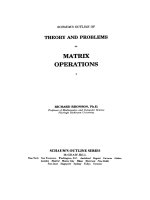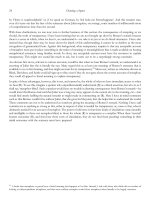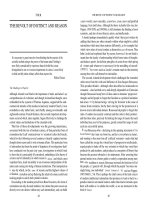schaum s easy outline of principles of economics based on schaum s outline of theory and problems of principl phần 2 potx
Bạn đang xem bản rút gọn của tài liệu. Xem và tải ngay bản đầy đủ của tài liệu tại đây (365.84 KB, 15 trang )
Solution:
a. At point A, society has more consumer goods and services in the
current period. Point C, however, provides the possibility of a larger
quantity of consumer goods and services in the future because of addi-
tions to the economy’s stock of capital resources. Here the economy’s
productive capabilities and thus production-possibilities frontier will ex-
pand (perhaps through the addition of a new factory) and thereby provide
an increased output of consumer goods and services in a future period.
b. As discussed in a., society must forgo purchases of consumer
goods and services now if it is to increase its capital and thereby expand
production capabilities. Thus, people must be willing to save, and have
10 PRINCIPLES OF ECONOMICS
Figure 1-3
fewer goods and services now, so that resources can be used in the cur-
rent period to produce capital goods.
Solved Problem 1.4 Figure 1-4 presents a production-possibility fron-
tier for food and clothing.
a. What is the opportunity cost of increasing food production from 0
to 2 million units, from 2 million to 4 million units, and from 4 million
to 6 million units?
b. What is happening to the opportunity cost of increasing food pro-
duction from 0 to 6 million units?
c. Explain how the shape of the production-possibility frontier im-
plies increasing costs for the production of clothing.
CHAPTER 1: Introduction to Economics
11
Figure 1-4
Solution:
a. In increasing food production from 0 to 2 million units, produc-
tion of clothing decreases from 16,000 to 15,000 units. Thus, the oppor-
tunity cost of producing the first 2 million units of food is 1 thousand units
of clothing. The opportunity cost of a second and third additional 2 mil-
lion units is 2,000 and 3,000 units of clothing, respectively.
b. The opportunity cost of increasing food production is increasing
from 1,000 units of clothing to 2,000 to 3,000 units of clothing.
c. Increasing clothing and food costs are reflected in a concave (out-
ward-sloping) production-possibility frontier. Moving down the frontier
from point A to points B, C, D, E, and F shows that to produce 2 million
incremental units of food (the 2-million-unit-length horizontal dashed
lines in Figure 1-4), we must give up more and more units of clothing (the
vertical dashed lines of increasing length).
Solved Problem 1.5 Explain how division of labor and specialization
enhance production in an advanced society.
Solution:
Through the division of labor and specialization, the population within a
given geographic region, instead of being self-sufficient and producing
the full range of goods and services wanted, can concentrate its energies
and time in the production of only a few goods and services in which its
efficiency is greatest. Thus, specialization and division of labor allow
greater output. By then exchanging some of the goods and services so
produced for different goods and services produced similarly within a dif-
ferent geographic region, the regions’populations as a whole end up con-
suming a larger number and greater diversity of goods and services than
would otherwise be the case.
12 PRINCIPLES OF ECONOMICS
Chapter 2
Demand, Supply,
and Equilibrium
In This Chapter:
✔ Demand
✔ Supply
✔ Equilibrium Price and Quantity
✔ Government and Price
Determination
✔ Elasticity
✔ True or False Questions
✔ Solved Problems
Demand
The demand schedule for an individual specifies
the units of a good or service that the individual is
willing and able to purchase at alternative prices
during a given period of time. The relationship be-
tween price and quantity demanded is inverse:
more units are purchased at lower prices because
of a substitution effect and an income effect. As a
commodity’s price falls, an individual normally
purchases more of this good since he or she is like-
13
Copyright 2003 by The McGraw-Hill Companies, Inc. Click Here for Terms of Use.
ly to substitute it for other goods whose price has remained unchanged.
Also, when a commodity’s price falls, the purchasing power of an indi-
vidual with a given income increases, allowing for greater purchases of
the commodity. When graphed, the inverse relationship between price
and quantity demanded appears as a negatively sloped demand curve. A
market demand schedule specifies the units of a good or service all indi-
viduals in the market are willing and able to purchase at alternative prices,
i.e., Q
d
= f (P).
Example 2.1
Table 2.1 gives an individual’s demand and the market demand for a com-
modity. Column 2 shows one individual’s demand for corn—the bushels
of corn that one individual is willing and able to buy per month at alter-
native prices. We find, for example, that the individual buys 3.5 bushels
of corn each month when the price is $5 per bushel. If there are 1,000 in-
dividuals in the market, the market demand for corn is the sum of the
quantities the 1,000 individuals will buy at each price. So for example,
1,000 individuals collectively are willing to purchase 3,500 bushels of
corn each month at $5 per bushel. The market demand is shown in the
last column, which shows the typical relationship between quantity de-
manded and price, i.e., more units of a commodity are demanded at low-
er prices. The market demand for corn is plotted in Figure 2-1 and the
curve is labeled D. Note that the demand curve is negatively sloped.
The market demand for a good or service is influenced not only by
the commodity’s price, but also by the price of other goods and services,
14 PRINCIPLES OF ECONOMICS
Table 2.1
disposable income, wealth, tastes, and the size of the market. In present-
ing the market demand for corn of Table 2.1 and Figure 2-1, variables oth-
er than the commodity’s price are held constant. This relationship is pre-
sented as Q
d
= f (P
corn
), ceteris paribus, where ceteris paribus indicates
that variables other than the price of corn are unchanged. When one or
more of these variables change, there is a change in demand and there-
fore a shift of the demand curve. For example, the market demand curve
shifts up and to the right when there is an increased preference for the
commodity, when income increases, and when the price of a substitute
commodity rises and/or the price of a complementary good declines. A
substitute good can be used instead of the good considered (wheat for
corn), and a complementary good is used together with the good consid-
ered (butter with corn).
A common error made by the beginning economics student is failure
to differentiate between a change in demand and a change in quantity de-
manded. A change in demand refers to a shift of the demand curve be-
cause a variable other than price has changed. A change in quantity de-
manded occurs when there is a change in the commodity’s price, resulting
in a movement along an existing demand curve.
CHAPTER 2: Demand, Supply, and Equilibrium
15
Figure 2-1
Remember
There is a distinct difference be-
tween demand and quantity de-
manded, and the two must not be
confused.
Example 2.2
The market demand for corn from Table 2.1 was plotted in Figure 2-1 and
labeled D. The market demand shifts up and to the right from D to D
1
when the market size increases—for example, when the number of indi-
viduals in this market increases from 1,000 to 1,200. Should the price of
wheat then increase—and individuals substitute corn for wheat in their
diets—the market demand curve for corn again shifts up and to the right,
this time from D
1
to D
2
.
Supply
A supply schedule specifies the units of a good or service that a produc-
er is willing to supply (Q
s
) at alternative prices over a given period of
time, i.e, Q
s
= f (P). The supply curve normally has a positive (upward)
slope, indicating that the producer must receive a higher price for in-
creased output due to the principle of increasing costs. (Review Chapter
1). A market supply curve is derived by summing the units each individ-
ual producer is willing to supply at alternative prices. A typical market
supply curve (labeled S) is plotted in Figure 2-2.
The market supply curve shifts when the number and/or size of pro-
ducers changes, factor prices (wages, interest, and/or rent paid to eco-
nomic resources) change, the cost of materials changes, technological
progress occurs, and/or the government subsidizes or taxes output.
The market supply curve shifts down and to the right with more pro-
ducers entering the market, decreases in factor or materials prices, im-
provement in technology, and government subsidization. A change in
supply thereby denotes a shift of the supply curve. A change in quantity
16 PRINCIPLES OF ECONOMICS
supplied indicates a change in the commodity’s price and therefore a
movement along an existing supply curve. In Figure 2-2, if the number
of producers increases, the market supply curve shifts down and to the
right from S to S
1
. If a technological improvement in corn production also
develops, the market supply curve shifts further downward from S
1
to S
2
.
Equilibrium Price and Quantity
Equilibrium occurs at the intersection of the market supply and market
demand curves. At this intersection, quantity demanded equals quantity
supplied, i.e., the quantity that individuals are willing to purchase exact-
ly equals the quantity producers are willing to supply. A surplus exists at
prices higher than the equilibrium price since the quantity demanded falls
short of the quantity supplied. At prices lower than the equilibrium price,
there is a shortage of output since quantity demanded exceeds quantity
supplied. Once achieved, the equilibrium price and quantity persist until
there is a change in demand and/or supply.
CHAPTER 2: Demand, Supply, and Equilibrium 17
Figure 2-2
You Need to Know
Economists spend much time and effort in analyz-
ing where and how market equilibrium is achieved.
Its importance cannot be overstated.
Equilibrium price and/or equilibrium quantity change when the mar-
ket demand and/or market supply curves shift. Equilibrium price and
equilibrium quantity both rise when there is an increase in market demand
with no change in the market supply curve. Equilibrium price falls while
equilibrium quantity increases when market supply increases and de-
mand is unchanged.
Government and Price Determination
The government may intervene in the market and mandate a maximum
price (price ceiling) or minimum price (price floor) for a good or service.
For example, some city governments in the U.S. legis-
late the maximum price that a landlord can charge a ten-
ant for rent. Such rent-control policies, though well-
intentioned, result in a disequilibrium in the housing
market since, at the government-mandated price ceiling,
the quantity of housing supplied falls short of the quan-
tity of housing demanded. An example of minimum
prices (price floors) in the U.S. is the minimum wage. Price floors result
in market disequilibrium in that quantity supplied at the mandated price
exceeds quantity demanded.
The government can alter an equilibrium price by changing market
demand and/or market supply. The government can restrict demand by
rationing a good, as occurred for many items during World War II. Equi-
librium price can be altered by shifting the market supply curve. A tax on
a good raises its supply price—shifts the market supply curve up and to
the left—and causes the equilibrium price to increase and the equilibri-
um quantity to fall. A subsidy to the producer will do the opposite and
lower equilibrium price and raise equilibrium quantity.
18 PRINCIPLES OF ECONOMICS
Elasticity
Market prices will change whenever shifts in supply or demand occur.
Example 2.3
Table 2.2 gives a hypothetical market demand and supply schedule for
wheat; it shows whether a surplus or shortage occurs at each price and in-
dicates the pressure on price toward equilibrium. Thus, the equilibrium
price is $2 because the quantity demanded, 4,500 bushels of wheat per
month, equals the quantity supplied.
The elasticity of demand (E
D
) measures the percentage change in the
quantity demanded of a commodity as a result of a given percentage in
its price. The formula is
E
D
can be calculated in terms of the new quantity and price, or with the
original quantity and price. However, different results would then be ob-
tained. To avoid this problem, economists generally measure E
D
in terms
of the average quantity and the average price, as follows:
E
D
is a pure number. Thus, it is a better measurement tool than the slope,
which is expressed in terms of the units of measurement. E
D
is always
E
D
=÷
change in quantity demanded
(sum of quantities demanded) / 2
change in price
(sum of prices) / 2
E
D
=
percentage change in the quantity demanded
percentage change in price
CHAPTER 2: Demand, Supply, and Equilibrium 19
Table 2.2
expressed as a positive number, even though price and quantity demand-
ed move in opposite directions. The demand curve is said to be elastic if
E
D
> 1, unitary elastic if E
D
= 1, and inelastic if E
D
< 1.
Don’t Forget!
Different formulas are used to compute elasticity
and slope. A simple glance at a graph is not enough
to determine whether a curve has a high or low
elasticity.
Example 2.4
The elasticity between the quantities demanded at $4 and $3 of Table 2.2
is calculated below using the average quantities and prices.
Thus, we say that this demand curve is elastic (on the average) be-
tween these two points. The elasticity of demand is greater (1) the greater
the number of good substitutes available, (2) the greater the proportion
of income spent on the commodity, and (3) the longer the time period con-
sidered.
When the price of a commodity falls, the total revenue of producers
(price times quantity) increases if E
D
> 1, remains unchanged if E
D
= 1,
and decreases if E
D
< 1. This occurs because when E
D
> 1, the percent-
age increase in quantity exceeds the percentage decline in price and so
total revenue (TR) increases. When E
D
= 1, the percentage increase in
quantity equals the percentage decline in price and so TR remains un-
changed. Finally, when E
D
< 1, the percentage increase in quantity is less
than the percentage decline in price, and so TR falls.
The elasticity of supply (E
S
) measures the percentage change in the
quantity supplied of a commodity as a result of a given percentage change
in its price. We again use the average quantity and price as follows:
E
D
=
+
÷
+
=÷==
1
232
1
432
1
25
1
35
35
25
14
()/()/ . .
.
.
.
20 PRINCIPLES OF ECONOMICS
E
S
is a pure number and is positive because price and quantity move
in the same direction. Supply is said to be elastic if E
S
> 1, unitary elas-
tic if E
S
= 1, and inelastic if E
S
< 1.
Example 2.5
The (average) elasticity between the quantities supplied at $1 and $2 of
the supply schedule of Table 2.2 is
True or False Questions
1. There is a decrease in the demand for a commodity when the price
of a substitute commodity increases.
2. When the supply curve is positively sloped, an increase in de-
mand will result in a larger quantity supplied.
3. A surplus exists when the market price is above the equilibrium
price.
4. Government subsidization of firms producing Good A results in
an increase in the demand for Good A.
5. Demand is inelastic if the percentage increase in quantity exceeds
the percentage decrease in price.
6. A decline in price leaves total revenue unchanged when E
D
= 1.
Answers: 1. False; 2. True; 3. True; 4. False; 5. False; 6. True
Solved Problems
Solved Problem 2.1 Explain what happens to the demand curve for air
transportation between New York City and Washington, D.C., as a result
of the following events:
a. The income of households in metropolitan New York and Wash-
ington, D.C., increases 20%.
E
S
=
+
÷
+
=÷≅
2
25 45 2
1
12 2
1
35
1
15
043
(. .)/ ( )/ . .
E
S
=÷
change in quantity supplied
(sum of quantities supplied) / 2
change in price
(sum of prices) / 2
CHAPTER 2: Demand, Supply, and Equilibrium 21
b. The cost of a train ticket between New York City and Washington,
D.C., is reduced 50%.
c. The price of an airline ticket decreases 20%.
Solution:
a. Individuals will travel more since they have more disposable in-
come. The demand for air transportation between NYC and Washington
increases; the demand curve shifts up and to the right.
b. The cost of an alternative mode of transportation between NYC
and Washington has decreased; thus, more individuals will travel by train
between NYC and Washington. The demand for air transportation de-
creases; the demand curve shifts down and to the left.
c. There is no shift, but there is a movement down the existing de-
mand curve; the lower price for an airline ticket results in an increase in
the number of people traveling (quantity demanded) by air between NYC
and Washington.
Solved Problem 2.2 Suppose the market supply and demand curves for
Good A are initially S and D, respectively, in Figure 2-3; equilibrium
price is $3 and equilibrium quantity is 280 units.
22 PRINCIPLES OF ECONOMICS
Figure 2-3
a. Suppose improved technology in the production of Good A shifts
the market supply curve from S to SЈ, ceteris paribus. After the initial
supply shift, what is the relationship between quantity demanded and
quantity supplied at the initial $3 equilibrium price?
b. What is the new equilibrium price and quantity after the techno-
logical advance has increased the supply of Good A?
Solution:
a. Quantity demanded for market schedule D is 280 units when the
price is $3, while market supply is 330 units. There is a surplus of Good
A at the initial $3 equilibrium price which puts downward pressure on the
price of Good A.
b. Equilibrium price falls from $3 to $2 as a result of the increase in
market supply; equilibrium quantity increases from 280 to 320 units.
Solved Problem 2.3 Why has the federal government placed price floors
on some agricultural goods?
Solution: A price floor is a government-mandated price that exists above
the market’s equilibrium price; price floors result in a surplus of produc-
tion. While market demand for most agricultural commodities is rela-
tively stable over time, market supply is very much influenced by the
weather. A drought, for example, decreases supply and pushes up prices
while a bumper crop can severely depress agricultural prices. The prof-
itability of farming becomes uncertain, as does the price of food products
and the income needed to feed a household. Thus, the reasons for agri-
cultural price supports (price floors) are: (1) to stabilize farmer incomes
and encourage farmers to continue farming whether there are bumper
crops or droughts; (2) to provide a steadier flow of agricultural products
at relatively stable prices; and (3) to stabilize the amount of income that
households need to spend on food.
Solved Problem 2.4
a. Is the demand for table salt elastic or inelastic? Why?
b. Is the demand for stereos elastic or inelastic? Why?
Solution:
a. The demand for salt is inelastic because there are no good substi-
tutes for salt and households spend a very small portion of their total in-
CHAPTER 2: Demand, Supply, and Equilibrium
23
come on this commodity. Even if the price of salt were to rise substan-
tially, households would reduce their purchases of salt little.
b. The demand for stereos is elastic because stereos are expensive
and, as a luxury rather than a necessity, their purchase can be postponed
or avoided when their price rises. One could also use the radio as a par-
tial substitute for a stereo.
Solved Problem 2.5
a. Should the price of a subway ride or bus ride be increased or de-
creased if total revenue needs to be increased?
b. What about the price of a taxi ride?
Solution:
a. To the extent that there are no inexpensive good substitutes for
public transportation in metropolitan areas, the demand for subway and
bus rides is inelastic. Their prices should, therefore, be increased to in-
crease total revenue. However, this can be self-defeating. Sharply in-
creasing the price of public transportation will encourage people to use
their cars and increase congestion and pollution.
b. For taxi rides, the case is likely to be different. Taxi rides are rel-
atively expensive; an increase in their price may encourage people to rely
much more on their cars and public transportation. To the extent that this
makes the demand for taxi rides elastic, total revenue will fall when the
price of taxi rides is increased.
24 PRINCIPLES OF ECONOMICS









